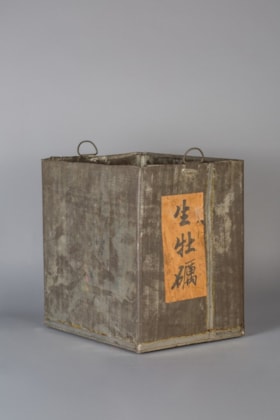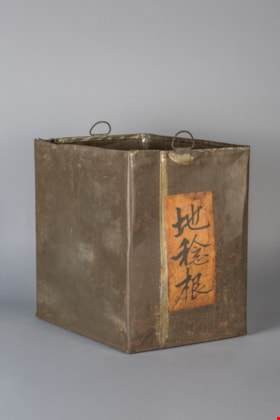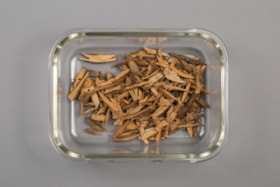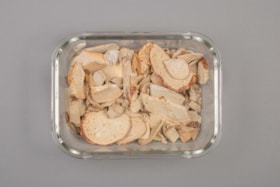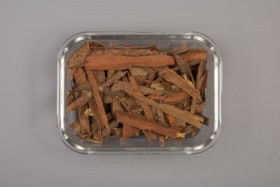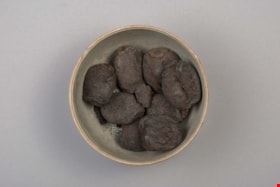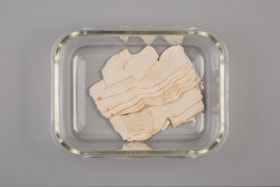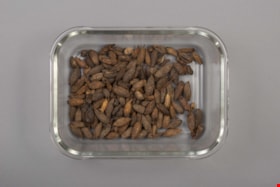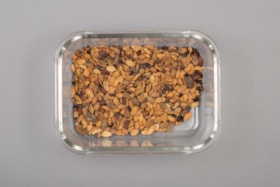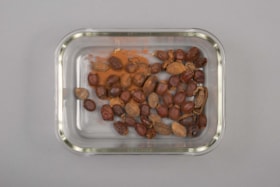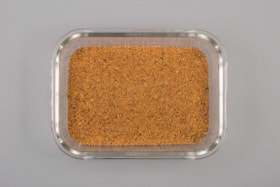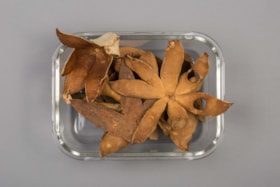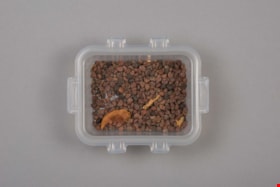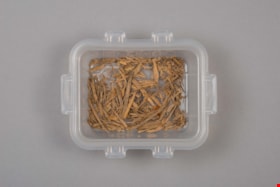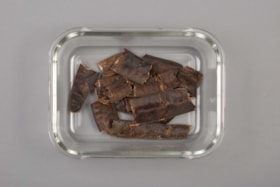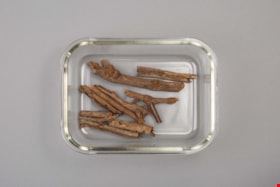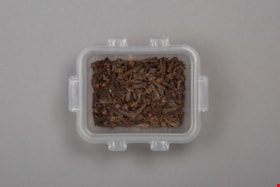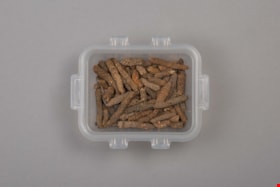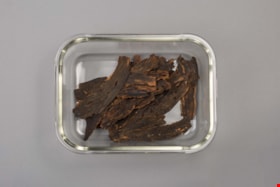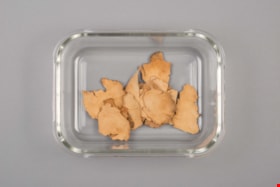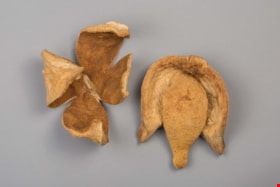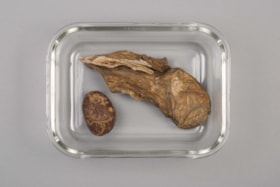Trades license for Way Sang Yuen Wat Kee & Co.
https://search.heritageburnaby.ca/link/museumdescription10551
- Repository
- Burnaby Village Museum
- Date
- 1970
- Collection/Fonds
- Way Sang Yuen Wat Kee & Co. fonds
- Description Level
- Item
- Physical Description
- 1 textual record
- Scope and Content
- Item consists of a Trades License from the Corporation of the City of Victoria issued to "Lim Yow, / Way Sang Yuen Wat Kee & Co. / 1620 Government St., / Victoria, B.C." for "Patent Medicines".
- Repository
- Burnaby Village Museum
- Collection/Fonds
- Way Sang Yuen Wat Kee & Co. fonds
- Description Level
- Item
- Physical Description
- 1 textual record
- Scope and Content
- Item consists of a Trades License from the Corporation of the City of Victoria issued to "Lim Yow, / Way Sang Yuen Wat Kee & Co. / 1620 Government St., / Victoria, B.C." for "Patent Medicines".
- Accession Code
- HV975.5.10ac
- Date
- 1970
- Media Type
- Textual Record
- Notes
- Title based on contents of item
Way Sang Yuen Wat Kee & Co.
https://search.heritageburnaby.ca/link/museumdescription4648
- Repository
- Burnaby Village Museum
- Date
- 1908-1975
- Collection/Fonds
- Way Sang Yuen Wat Kee & Co. fonds
- Description Level
- Fonds
- Physical Description
- 3 folders of textual records + 180 photographs + ephemera + 1 map + 1 architectural drawing
- Scope and Content
- Fonds consists of records acquired from the Chinese Herbalist shop “Way Sang Yuen Wat Kee & Co” operating in Victoria from 1905 until 1968. Textual records include a few pieces of correspondence, receipts and ephemera addressed to "Way Sang Yuen Wat Kee & Co.", Lim You and Lim Yau (Yew Long Lum) wh…
- Repository
- Burnaby Village Museum
- Collection/Fonds
- Way Sang Yuen Wat Kee & Co. fonds
- Description Level
- Fonds
- Physical Description
- 3 folders of textual records + 180 photographs + ephemera + 1 map + 1 architectural drawing
- Scope and Content
- Fonds consists of records acquired from the Chinese Herbalist shop “Way Sang Yuen Wat Kee & Co” operating in Victoria from 1905 until 1968. Textual records include a few pieces of correspondence, receipts and ephemera addressed to "Way Sang Yuen Wat Kee & Co.", Lim You and Lim Yau (Yew Long Lum) while the shop was in operation at 1620 Government Street in the 1940s. Some of the records are written in English while a portion are written in Cantonese and haven't been translated. Most of the photographs document the content of the original shop at the time of aquistion in 1975. Some photographs of unidentified people may be related to the owner or proprietor of the shop. A collection of other photographs document various Chinese Canadian organizations that were in operation in Victoria. Records are arranged into the following series: 1) Way Sang Yuen Wat Kee & Co. photographs series 2) Way Sang Yuen Wat Kee & Co. documents series
- History
- The Chinese Herbalist shop "Way Sang Yuen Wat Kee & Co" operated in Victoria, BC from about 1905 until [1968]. The meaning of "Way Sang Yuen Wat Kee & Co" can be translated as "Collection, Life, Source, Alive, Shop" although many interpretations can be taken since each Chinese character can have several meanings. Contents of the shop were purchased by the Burnaby Village Museum in 1975 and reassembled as a permanent display in the Burnaby Village Museum. The shop’s original owner was Ng Chee Fong who opened the shop ca.1905. In 1921, Ng returned to Hong Kong and sold the business to Lam Yuen and Wong Ying who were from Vancouver. Lam Yuen and Wong Ying employed Lum Chuck Yue to operate the shop. Lum Chuck Yue had formerly operated a small herbal counter in a Chinese apothecary store on the south side of Fisgard Street, Victoria. In 1924 Lam Yuen and Wong Ying purchased Wah Sun & Co. from Lee S. Yew and Way Sang Yuen Wat Kee & Co. moved into the Wah Sun premises at 1620 Government Street in the Lee Block . The furnishings and fixtures of both stores were combined, with the more elaborate fixtures from WSYWK remaining as part of the public part of the shop and the plainer fixtures of Wah Sun moved into the workroom and basement. In the 1930s Lum Chuck Yue took over the business and became the proprietor. In about 1934, Tan Yi Tang purchased the business and the shop reopened as Way Sang Yuen Wat Kee & Co. following renovations with Lum Yew Jong as the shop's proprietor. Lum Yew Jong continued to operate the shop until his death in 1967 at the age of 68 years. Following Lum’s death, the property and contents of the shop were purchased by Mr. J. Watson Marles, a local owner operator of an antique store at 1714 Government Street. The shop and contents went through a few more private owners including Rodney Pain before it was purchased by the Heritage Village Museum in 1975 with funds made available by the Vancouver Foundation and the Province of British Columbia. Contents of the original shop were reasembled in a reconstructed building as a permanent display on site at the Burnaby Village Museum.
- Creator
- Way Sang Yuen Wat Kee & Company
- Accession Code
- HV975.5
- BV985.5331
- BV017.7
- Access Restriction
- Restricted access
- Reproduction Restriction
- May be restricted by third party rights
- Date
- 1908-1975
- Related Material
- See also Artifacts under Accessions HV975.5; BV985.5331 and BV017.7
- Notes
- Title based on contents of fonds
Way Sang Yuen Wat Kee & Co. documents series
https://search.heritageburnaby.ca/link/museumdescription19022
- Repository
- Burnaby Village Museum
- Date
- 1910-1970
- Collection/Fonds
- Way Sang Yuen Wat Kee & Co. fonds
- Description Level
- Series
- Physical Description
- textual records + 1 map + 1 architectural drawing
- Scope and Content
- Series consists of small collection of business records and newspapers that were part of the contents of the Way Sang Yuen Wat Kee & Co. at 1620 Government Street, Victoria in 1975.
- Repository
- Burnaby Village Museum
- Collection/Fonds
- Way Sang Yuen Wat Kee & Co. fonds
- Description Level
- Series
- Physical Description
- textual records + 1 map + 1 architectural drawing
- Scope and Content
- Series consists of small collection of business records and newspapers that were part of the contents of the Way Sang Yuen Wat Kee & Co. at 1620 Government Street, Victoria in 1975.
- Accession Code
- HV975.5
- BV985.5331
- BV017.7
- Date
- 1910-1970
- Related Material
- See also Artifacts under Accessions HV975.5; BV985.5331 and BV017.7
- Notes
- Title based on contents of series
bin
https://search.heritageburnaby.ca/link/museumartifact24711
- Repository
- Burnaby Village Museum
- Accession Code
- HV975.5.1208
- Description
- Tin, has Chinese characters on it
- Object History
- This item originates from the Chinese Herbalist Store "Way Sang Yuen Wat Kee & Co.", Victoria B.C.
- Classification
- Chemical T&E
- Measurements
- 25cm height x 17cm width x 15cm depth
Images
bin
https://search.heritageburnaby.ca/link/museumartifact24713
- Repository
- Burnaby Village Museum
- Accession Code
- HV975.5.1210
- Description
- Rectangular metal container with two small D shaped handles welded on opposite sides of the rim. Orange paper label has three handwritten Chinese characters.
- Object History
- This item originates from the Chinese Herbalist Store "Way Sang Yuen Wat Kee & Co.", Victoria B.C.
- Classification
- Chemical T&E
- Marks/Labels
- Chinese characters on label, which literally translate to mean "ground" "ripe grain" "root". When adjusted for English translation, "Root of Twelve stamen Melastoma Dodecandrum Lour". Uses in Chinese medicine: Bitter, slightly sweet, neutral. For liver, spleen and lung meridians. Action: Promote blood circulation, stop bleeding, eliminate dampness and remove toxicity. Indications: Scrofula, toothache, dysentery, leucorrhea, uterine bleeding, abdominal pain after delivery, dysmenorrhea."
- Measurements
- 25cm height x 17cm width x 15cm depth
Images
botanical specimen
https://search.heritageburnaby.ca/link/museumartifact88633
- Repository
- Burnaby Village Museum
- Accession Code
- BV017.7.5
- Description
- English Name: Lightyellow Sophora Root Chinese Pinyin Name: Kushen (KuShen) Physical Description: small cut or chipped pieces of root, pale brown, with bark still attached Production Regions: Primarily produced in the Chinese provinces of Henan, Hebei, Shanxi,etc. Functions: Clears heat, dries dampness, dispels wind, kills worms. Apply to diarrhea due to damp heat, hematochezia due to intestine wind, jaundice, dysuria, edema, vaginal discharge, vaginal itch, abscess and tinea, lepra, skin itch, sore with damp toxin
- Object History
- Collection of original raw contents of the Chinese Herbalist Shop, Way Sang Yuen Wat Kee, Victoria BC, as purchased from Rodney Pain in 1974.
- Reference
- Hong Kong Chinese Materia Medica Standards Volume 4. Retrived on 25 July 2017. URL: http://www.cmd.gov.hk/doc/search/Sophorae_Flavescentis_Radix_v4_e.pdf Chinese Medicinal Material Images Database, School of Chinese Medicine, Hong Kong Baptist University. URL: http://libproject.hkbu.edu.hk/was40/detail?channelid=47953&lang=eng&searchword=pid=B00018 Compendium of Materia Medica (Bencao Gangmu), 2003; Taiwan Herbal Pharmacopeia, 2014.
Images
botanical specimen
https://search.heritageburnaby.ca/link/museumartifact88638
- Repository
- Burnaby Village Museum
- Accession Code
- BV017.7.10
- Description
- unidentified
- Object History
- Collection of original raw contents of the Chinese Herbalist Shop, Way Sang Yuen Wat Kee, Victoria BC, as purchased from Rodney Pain in 1974.
Images
botanical specimen
https://search.heritageburnaby.ca/link/museumartifact88639
- Repository
- Burnaby Village Museum
- Accession Code
- BV017.7.11
- Description
- Cassia bark or Rougui, also known as Cinnamomi Cortex.
- Object History
- Collection of original raw contents of the Chinese Herbalist Shop, Way Sang Yuen Wat Kee, Victoria BC, as purchased from Rodney Pain in 1974.
- Used to warm spleen and stomach, elminates cold accumulation, frees blood and veins.
Images
botanical specimen
https://search.heritageburnaby.ca/link/museumartifact88645
- Repository
- Burnaby Village Museum
- Accession Code
- BV017.7.17
- Description
- Radix Rehmanniae
- Object History
- Collection of original raw contents of the Chinese Herbalist Shop, Way Sang Yuen Wat Kee, Victoria BC, as purchased from Rodney Pain in 1974.
Images
botanical specimen
https://search.heritageburnaby.ca/link/museumartifact88647
- Repository
- Burnaby Village Museum
- Accession Code
- BV017.7.19
- Description
- English Name: Snakegourd Root Chinese Pinyin Name: Tianhuafen (TianHuaFen) Physical Description: thin longitudinal slices of dried root, white; slightly irregular rectangular shapes with horizontal rippling; surfaces are dotted in places; some pieces broken Production Regions: Primarily produced in the Chinese provinces of Hebei, Shandong, Shaanxi, Shanxi. Functions: Clears heat, drains fire, engenders fluid, stops thirst, expels pus, eliminates swelling. Apply to thirst due to heat, diabetes, jaundice, hemoptysis due to dryness of lung, swelling abscess, hemorrhoid fistula. As for apply to diabetes, often combined with medicinal material, which can nourish yin, to achieve the effect.
- Object History
- Collection of original raw contents of the Chinese Herbalist Shop, Way Sang Yuen Wat Kee, Victoria BC, as purchased from Rodney Pain in 1974.
- Reference
- Chinese Medicinal Material Images Database, School of Chinese Medicine, Hong Kong Baptist University. URL: http://libproject.hkbu.edu.hk/was40/detail?channelid=47953&lang=eng&searchword=pid=B00104
Images
botanical specimen
https://search.heritageburnaby.ca/link/museumartifact88658
- Repository
- Burnaby Village Museum
- Accession Code
- BV017.7.30
- Description
- litchi seed (Litchi Chinensis); used to relieve pain in colic, gastralgia, and orchitis
- Object History
- Collection of original raw contents of the Chinese Herbalist Shop, Way Sang Yuen Wat Kee, Victoria BC, as purchased from Rodney Pain in 1974.
- Reference
- Keys, John D. "Chinese Herbs". Rutland: Charles E Tuttle Company, Inc., 1976.
Images
botanical specimen
https://search.heritageburnaby.ca/link/museumartifact88659
- Repository
- Burnaby Village Museum
- Accession Code
- BV017.7.31
- Description
- Seed of Chinese Wampee
- Object History
- Collection of original raw contents of the Chinese Herbalist Shop, Way Sang Yuen Wat Kee, Victoria BC, as purchased from Rodney Pain in 1974.
Images
botanical specimen
https://search.heritageburnaby.ca/link/museumartifact88660
- Repository
- Burnaby Village Museum
- Accession Code
- BV017.7.32
- Description
- English Name: Villous Amomun Fruit Chinese Pinyin Name: Sharen (ShaRen / SuoShaMiRen) Physical Description: many small dried fruits, flattened ovals, ranging from pale tan to darker reddish brown colour; some have longitudinal ridges, others appear wrinkled, with stem protrusion one end or hole; at least one is broken open Production Regions: Primarily produced in the Chinese provinces of Guangdong, Guangxi. Imported sha ren is produced in Vietnam, Thailand, Myanmar, and Indonesia. Functions: Transforms dampness, increases appetite, warms spleen, relieves diarrhea, regulates qi, calms fetus. Apply to retention of dampness in the middle, abdominal fullness and anorexia, deficiency and cold spleen and stomach, vomit and diarrhea, pernicious vomiting, restless fetal movements.
- Object History
- Collection of original raw contents of the Chinese Herbalist Shop, Way Sang Yuen Wat Kee, Victoria BC, as purchased from Rodney Pain in 1974.
- Reference
- Chinese Medicinal Material Images Database, School of Chinese Medicine, Hong Kong Baptist University. URL: http://libproject.hkbu.edu.hk/was40/detail?channelid=47953&lang=eng&searchword=pid=B00254 ; Compendium of Materia Medica (Bencao Gangmu), 2003;
Images
botanical specimen
https://search.heritageburnaby.ca/link/museumartifact88666
- Repository
- Burnaby Village Museum
- Accession Code
- BV017.7.38
- Description
- mustard seed; used internally to discharge mucus
- Object History
- Collection of original raw contents of the Chinese Herbalist Shop, Way Sang Yuen Wat Kee, Victoria BC, as purchased from Rodney Pain in 1974.
- Reference
- Keys, John D. "Chinese Herbs". Rutland: Charles E Tuttle Company, Inc., 1976.
Images
botanical specimen
https://search.heritageburnaby.ca/link/museumartifact88669
- Repository
- Burnaby Village Museum
- Accession Code
- BV017.7.41
- Description
- mandarin orange peel (Citrus Nobilis); used to sooth the stomach, to aid digestion, to discharge mucus
- Object History
- Collection of original raw contents of the Chinese Herbalist Shop, Way Sang Yuen Wat Kee, Victoria BC, as purchased from Rodney Pain in 1974. Orange Peel is used as a traditional seasoning in Chinese cooking and in traditional medicine. Today, orange peel essential oil is a common beauty product used around the world.
- Reference
- Keys, John D. "Chinese Herbs". Rutland: Charles E Tuttle Company, Inc., 1976.
Images
botanical specimen
https://search.heritageburnaby.ca/link/museumartifact88671
- Repository
- Burnaby Village Museum
- Accession Code
- BV017.7.43
- Description
- English Name: Pharbitis Seed / Lobedleaf Pharbitis Seed Chinese Pinyin Name: Qianniuzi (QianNiuZi) Physical Description: many small dried seeds, colours vary from light tan to dark brown; wedge-shaped with curved backs, like orange segments; backs have single groove Production Regions: Primarily produced in the Chinese provinces of Guangxi, Yunnan. Functions: Drains water, frees stools, eliminates phlegm, clears fluid, kills worms, attacks stagnation. Apply to edema and fullness, fecal and urinary stoppage, inverse qi and panting, worm stagnation and abdominal pain, ascariasis, taeniasis.
- Object History
- Collection of original raw contents of the Chinese Herbalist Shop, Way Sang Yuen Wat Kee, Victoria BC, as purchased from Rodney Pain in 1974.
- Reference
- Chinese Medicinal Material Images Database, School of Chinese Medicine, Hong Kong Baptist University. URL: http://libproject.hkbu.edu.hk/was40/detail?channelid=47953&lang=eng&searchword=pid=B00198 Compendium of Materia Medica (Bencao Gangmu), 2003; Taiwan Herbal Pharmacopeia, 2014.
Images
botanical specimen
https://search.heritageburnaby.ca/link/museumartifact88673
- Repository
- Burnaby Village Museum
- Accession Code
- BV017.7.45
- Description
- English Name: Chinese Eaglewood / Tambac Chinese Pinyin Name: Chenxiang (ChenXiang) Physical Description: wood fragments, small, light to medium brown; thin shavings or splinters in varying sizes Production Regions: Primarily produced in the Chinese provinces of Guangdong, Hainan, Guangxi, Fujian, Taiwan. Functions: Moves qi and relieves pain, warms the center and stops vomiting, promotes qi absorption and calms panting. Apply to chest and abdominal swelling pain, gastric cold and vomiting and hiccoughs, deficiency of kidney and inability to breathe due to adverse rising of qi.
- Object History
- Collection of original raw contents of the Chinese Herbalist Shop, Way Sang Yuen Wat Kee, Victoria BC, as purchased from Rodney Pain in 1974.
- Reference
- Chinese Medicinal Material Images Database, School of Chinese Medicine, Hong Kong Baptist University. URL: http://libproject.hkbu.edu.hk/was40/detail?channelid=47953&lang=eng&searchword=pid=B00421 Compendium of Materia Medica (Bencao Gangmu), 2003; Taiwan Herbal Pharmacopeia, 2014.
Images
botanical specimen
https://search.heritageburnaby.ca/link/museumartifact88674
- Repository
- Burnaby Village Museum
- Accession Code
- BV017.7.46
- Description
- English Name: Chinese Honeylocust Abnormal Fruit / Abnorma Chinese Honeylocust Fruit Chinese Pinyin Name: Zhuyazao (ZhuYaZao) Physical Description: dried fruit, large flat rectangular pieces torn from larger pods, dark brown with lighter brown areas; some pieces are curved along one side; leathery surfaces with creases and tears, and fraying along torn edges Production Regions: Primarily produced in the Chinese provinces of Shandong, Yunnan, Guizhou, Sichuan. Functions: Opens orifices, transforms phlegm, dispels wind, kills worms. Apply to apoplexy and lockjaw, head wind, inveterate wind evil, throat impediment, panting with phlegm, distention and fullness accumulation, blocking orifices, swelling abscess, ulcer, tinea, head sore
- Object History
- Collection of original raw contents of the Chinese Herbalist Shop, Way Sang Yuen Wat Kee, Victoria BC, as purchased from Rodney Pain in 1974.
- Reference
- Chinese Medicinal Material Images Database, School of Chinese Medicine, Hong Kong Baptist University. URL: http://libproject.hkbu.edu.hk/was40/detail?channelid=47953&lang=eng&searchword=pid=B00225; Compendium of Materia Medica (Bencao Gangmu), 2003; Taiwan Herbal Pharmacopeia, 2014.
Images
botanical specimen
https://search.heritageburnaby.ca/link/museumartifact88675
- Repository
- Burnaby Village Museum
- Accession Code
- BV017.7.47
- Description
- English Name: Cassia bark tree Twig Chinese Pinyin Name: Guizhi (GuiZhi) Physical Description: twigs, short, light brown, varying thicknesses, with some ridging and wrinkling along their lengths; some have short pieces branching off, some show a scar where a branching piece has broken off; some are cut or broken to blunt ends, others have bark missing at end, some have protruding bark ends with no wood inside Production Regions: Primarily produced in the Chinese provinces of Fujian, Guangdong, Guangxi. Functions: Promotes sweating, resolves the flesh, warms and frees the channels and vessels, assists yang in transforming qi, downbears qi. Apply to wind-cold type of common cold, abdominal cold pain, amenorrhea due to cold blood, joint impediment, phlegm and retained fluid, edema, palpitations, renal mass.
- Object History
- Collection of original raw contents of the Chinese Herbalist Shop, Way Sang Yuen Wat Kee, Victoria BC, as purchased from Rodney Pain in 1974. Cassia bark twig is also known as Chinese cinnamon and has been used in Chinese medicine for centuries. Most of the cinnamon sold in Canada’s supermarkets is Chinese cinnamon.
- Reference
- Chinese Medicinal Material Images Database, School of Chinese Medicine, Hong Kong Baptist University. URL: http://libproject.hkbu.edu.hk/was40/detail?channelid=47953&lang=eng&searchword=pid=B00138 Compendium of Materia Medica (Bencao Gangmu), 2003; Taiwan Herbal Pharmacopeia, 2014.
Images
botanical specimen
https://search.heritageburnaby.ca/link/museumartifact88680
- Repository
- Burnaby Village Museum
- Accession Code
- BV017.7.52
- Description
- English Name: Clove Chinese Pinyin Name: Dingxiang (DingXiang) Physical Description: small dried flower buds, dark brown and twiglike with rounded heads held by 4 sepals; lower portions are slightly tapered and rough Production Regions: Primarily produced in Zanzibar Island of Tanzania, as well as Malaysia and Indonesia. In China, it has been introduced into cultivation in the provinces of Hainan and Guangdong. Functions: Warms stomach, warms kidney. Apply to cold stomach and swelling pain, hiccup, vomiting and diarrhea, impediment, colic, ozostomia, toothache.
- Object History
- Collection of original raw contents of the Chinese Herbalist Shop, Way Sang Yuen Wat Kee, Victoria BC, as purchased from Rodney Pain in 1974.
- Reference
- Chinese Medicinal Material Images Database, School of Chinese Medicine, Hong Kong Baptist University. URL: http://libproject.hkbu.edu.hk/was40/detail?channelid=47953&lang=eng&searchword=pid=B00299 ; Compendium of Materia Medica (Bencao Gangmu), 2003;
Images
botanical specimen
https://search.heritageburnaby.ca/link/museumartifact88681
- Repository
- Burnaby Village Museum
- Accession Code
- BV017.7.53
- Description
- English Name: Long Pepper Fruit
- Chinese Pinyin Name: Bibo (Bibo)
- Physical Description: small medium-brown cylindrical fruit spikes of similar length and thickness, slight curve visible in some; small protuberances evenly distributed along pieces
- Production Regions: Primarily produced in Indonesia.
- Functions: Warms the center, disperses cold, downbears qi, relieves pain. Apply to cold pain of gastric cavity and abdomen, vomiting, diarrhea, nasosinusitis, hemicrania, externally used for toothache, coronary disease, angina pectoris; heart and abdominal cold pain, vomiting and sour regurgitation, diarrhea with intestine rumbling, cold diarrhea, yin hernia, headache, toothache.
- Object History
- Collection of original raw contents of the Chinese Herbalist Shop, Way Sang Yuen Wat Kee, Victoria BC, as purchased from Rodney Pain in 1974.
- Reference
- Chinese Medicinal Material Images Database, School of Chinese Medicine, Hong Kong Baptist University. URL: http://libproject.hkbu.edu.hk/was40/detail?channelid=47953&lang=eng&searchword=pid=B00156
Images
botanical specimen
https://search.heritageburnaby.ca/link/museumartifact88683
- Repository
- Burnaby Village Museum
- Accession Code
- BV017.7.55
- Description
- English Name: Lobed Kudzuvine Root Chinese Pinyin Name: Gegen (GeGen) Physical Description: roots, dried, flat, rough dark brown surfaces with longitudinal wrinkles; mostly rectangular but tapered in places Production Regions: Primarily produced in the Chinese provinces of Henan, Zhejiang, Guangdong, Hunan. Functions: Resolves exterior, abates heat, engenders fluid, outthrusts measles, raise yang, relieves diarrhea. Apply to fever and headache caused by exogenous pathogens, stiffness of the neck due to hypertension, hydrodipsia, diabetes, measles without adequate eruptions, dysentery of heat type, diarrhea.
- Object History
- Collection of original raw contents of the Chinese Herbalist Shop, Way Sang Yuen Wat Kee, Victoria BC, as purchased from Rodney Pain in 1974.
- Reference
- Chinese Medicinal Material Images Database, School of Chinese Medicine, Hong Kong Baptist University. URL: http://libproject.hkbu.edu.hk/was40/detail?channelid=47953&lang=eng&searchword=pid=B00063 Compendium of Materia Medica (Bencao Gangmu), 2003; Taiwan Herbal Pharmacopeia, 2014.
Images
botanical specimen
https://search.heritageburnaby.ca/link/museumartifact88693
- Repository
- Burnaby Village Museum
- Accession Code
- BV017.7.65
- Description
- English Name: Hypoglaucous Collett Yam Rhizome/ Hypoglaucous Yam Rhizome Chinese Pinyin Name: Fenpixie (FenPiXie) Physical Description: thin slices of rhizome, large, medium tan colour, irregular edges and shapes; surface is slightly rough; colour is darker and texture rougher or wrinkled near some edges; some pieces have cracks or tears in edges Functions: Promotes urination, dispels wind, promotes removing damp. Apply to wind and damp impediment, pain of waist and knees, dysuria, stranguria with turbid discharge, spermatorrhea, sore toxin due to damp and heat
- Object History
- Collection of original raw contents of the Chinese Herbalist Shop, Way Sang Yuen Wat Kee, Victoria BC, as purchased from Rodney Pain in 1974.
- Reference
- Chinese Medicinal Material Images Database, School of Chinese Medicine, Hong Kong Baptist University. URL: http://libproject.hkbu.edu.hk/was40/detail?channelid=47953&lang=eng&searchword=pid=B00056 Compendium of Materia Medica (Bencao Gangmu), 2003; Taiwan Herbal Pharmacopeia, 2014.
Images
botanical specimen
https://search.heritageburnaby.ca/link/museumartifact88698
- Repository
- Burnaby Village Museum
- Accession Code
- BV017.7.70
- Description
- English Name: Tomentose Pummelo Peel Chinese Pinyin Name: Huajuhong (HuaJuHong / YouPi) Physical Description: large pieces of dried fruit peel, medium tan colour; intact peel is inside-out, has 4 points curving inwards; outer peel is finely pitted, inner peel is whitish with veins; 1 point broken off halfway, another near tip Production Regions: Primarily produced in the Chinese area of Huazhou and Lianjiang of Guangdong. Functions: Disperses cold, dries dampness, promotes qi, eliminates phlegm. Apply to cough due to wind-cold, itching throat with phlegm, dyspepsia and chronic alcoholism, vomiting, nausea, painful abdominal mass.
- Object History
- Collection of original raw contents of the Chinese Herbalist Shop, Way Sang Yuen Wat Kee, Victoria BC, as purchased from Rodney Pain in 1974.
- Reference
- Chinese Medicinal Material Images Database, School of Chinese Medicine, Hong Kong Baptist University. URL: http://libproject.hkbu.edu.hk/was40/detail?channelid=47953&lang=eng&searchword=pid=B00183 ; http://libproject.hkbu.edu.hk/was40/detail?channelid=1288&lang=en&record=1&searchword=herb_id=%27D00050%27%20OR%20herb_id=%27D00051%27 ; Compendium of Materia Medica (Bencao Gangmu), 2003;
- Marks/Labels
- See HV975.5.1165 for label that likely accompanied the pummelo peel.
Images
botanical specimen
https://search.heritageburnaby.ca/link/museumartifact88702
- Repository
- Burnaby Village Museum
- Accession Code
- BV017.7.74
- Description
- English Name: Pubescent Angelica Root Chinese Pinyin Name: Duhuo (DuHuo / DuHuoGen) Physical Description: piece of dried root, brown, roughly rectangular, outward curve along one side, straighter along other side with one triangular protrusion; thicker at one end with smooth dark brown surface, some wrinkles, while other end tapers to a point; from mid-point to tapered end root appears to have many thin vertical layers varying in colour from light tan to medium brown Production Regions: Primarily produced in the Chinese provinces of Sichuan, Hubei. Functions: Dispels wind, eliminates dampness, frees cold, stops pain. apply to wind-cold and damp
- Object History
- Collection of original raw contents of the Chinese Herbalist Shop, Way Sang Yuen Wat Kee, Victoria BC, as purchased from Rodney Pain in 1974.
- Reference
- Chinese Medicinal Material Images Database, School of Chinese Medicine, Hong Kong Baptist University. URL: http://libproject.hkbu.edu.hk/was40/detail?channelid=47953&lang=eng&searchword=pid=B00052 Compendium of Materia Medica (Bencao Gangmu), 2003; Taiwan Herbal Pharmacopeia, 2014; Hong Kong Chinese Materia Medica Standards Volume 2. Retrived on 25 July 2017. URL: http://www.cmd.gov.hk/doc/search/Radix_Angelicae_Pubescentis_v2_e.pdf
